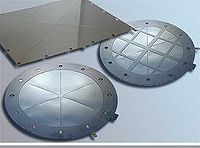Difference between revisions of "Explosion Vent Panels"
(Created page with "Category:Explosion Safety{{Knoppen}} <noinclude><!------------------------------------------------ * READ THIS FIRST * Only edit this page if you can improve the content. * ...") |
PurplePen19 (talk | contribs) |
||
| Line 7: | Line 7: | ||
* Please start editing this page after the /noinclude | * Please start editing this page after the /noinclude | ||
* -------------------------------------------------></noinclude> | * -------------------------------------------------></noinclude> | ||
[[File:Explosion Vent Panels_1.jpg|thumb|200px|right|Explosion Vent Panels]] | |||
'''Explosion Vent Panels''' open quickly at a predetermined pressure, controlling any excessive pressure of flames, and containing fragments towards a safe area in the event of an explosion. | |||
==Typical Components== | |||
*A slotted, perforated metal part | |||
*A seal membrane (usually in PTFE) | |||
*A protection section | |||
==Common Features== | |||
Accurate reliable and leak tight. | |||
Enhanced abrasion resistance. | |||
One-piece metal construction without slits on the process side avoiding product accumulation. | |||
Optional design for aseptic/sanitary applications. | |||
No fragile PTFE seal that may puncture and admit moisture. | |||
Superior dynamic performance due to low mass compared with composite designs. | |||
Operating pressures up to 60% of the minimum tagged pressure rating (80% under certain conditions). | |||
Thermal insulation available to permit use in operating temperatures to 2000°F/1093°C, to reduce heat loss or prevent condensation. | |||
Supplied with integral gaskets ready for installation. | |||
Fail-safe design, if damaged it will provide a relief opening below its rated pressure. | |||
==Video== | |||
<youtube>BL5vAGKlNJ0</youtube> | |||
Latest revision as of 06:20, 22 October 2012
Explosion Vent Panels open quickly at a predetermined pressure, controlling any excessive pressure of flames, and containing fragments towards a safe area in the event of an explosion.
Typical Components
- A slotted, perforated metal part
- A seal membrane (usually in PTFE)
- A protection section
Common Features
Accurate reliable and leak tight. Enhanced abrasion resistance. One-piece metal construction without slits on the process side avoiding product accumulation. Optional design for aseptic/sanitary applications. No fragile PTFE seal that may puncture and admit moisture. Superior dynamic performance due to low mass compared with composite designs. Operating pressures up to 60% of the minimum tagged pressure rating (80% under certain conditions). Thermal insulation available to permit use in operating temperatures to 2000°F/1093°C, to reduce heat loss or prevent condensation. Supplied with integral gaskets ready for installation. Fail-safe design, if damaged it will provide a relief opening below its rated pressure.
Video
